
It’s that time of year again. The record cold temperatures are over – we hope – but considering the wild fluctuations in our weather patterns, your customers may want heat one day and A/C the next. Here is some insight on how sophisticated BMW Climate Control systems function and how to diagnose them when something goes wrong.
Evolution
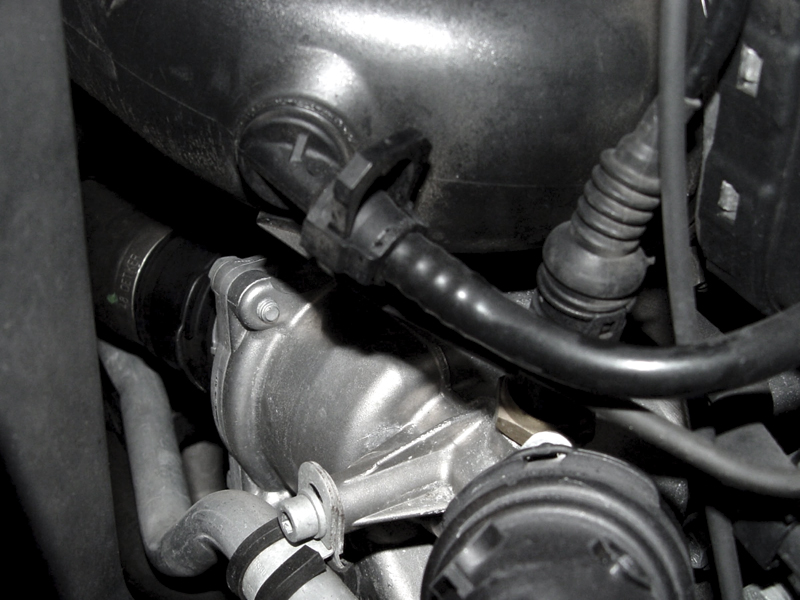
Here is the typical location of the E-Thermostat. While it does have an effect on coolant temperature, do not become sidetracked by it. If the thermostat is mechanically stuck open, that’s one thing. If the coolant is hot going to the heater control valve, check the valve next.
BMW’s climate control systems have evolved from the three-dial IHKS to the temperature feedback IHKR and IHKA systems. All systems control both heating and air conditioning, but there are subtle differences in how they go about it. Also, the IHKS/R/A systems control
rear window defrosting, but since it is through electrical means, straightforward electrical diagnostics apply. The old and new IHKS are non-feedback systems — while the temperature is computer controlled, it is not regulated. The IHKR/A systems are computer controlled and the temperature is regulated. On manual systems you merely set a temperature and that’s it. On computer regulated systems, a control unit monitors interior and exterior temperatures and modulates heating and cooling controls to adapt to any changes in the environment.
BMW added to customer comfort by installing dual climate control systems, so drivers and passengers can enjoy separate temperature control zones. Further advancements now include rear air conditioning and rear climate control systems. These technologically-advanced systems require computer control to adequately monitor cabin temperature, manipulate temperature controls and monitor the effects of these changes. Over the next few pages we will review BMW’s approach to heating, air conditioning, and computer control with the IHKS/R/A systems. We will discuss the heating system first, focusing on heating control inside the cabin. We’ll follow up with air conditioning, from compressor type to temperature control, then go over electronic and computerized mode door and blower motor control. Finally, we’ll look at the computer control and diagnostics involved in these advanced systems.
Keeping the temperature up
In order to provide heat inside the cabin, we first need a reliable heat source — the heated engine coolant. Of course, to assist in bringing coolant up to temperature faster, a thermostat blocks flow through the radiator until a calibrated temperature is reached. BMW has added an electronic control to what’s typically a single stage thermostat by incorporating a solenoid and a heating element. This heats up the wax element inside the thermostat itself, causing it to open sooner. This is referred to as “Characteristic Map†cooling.
If this E-Thermostat is malfunctioning, very often the DME will flag a code for it, so it’s always a good idea to check for DTCs (Diagnostic Trouble Codes) when dealing with heater problems. The exception is the Z8, which does not have an E-Thermostat. While this provides additional cooling capacity for the engine, it does not have a significant effect on the temperature of the heating system.
The heated coolant is piped into a heater control valve (the E90 from 6/05 production with IHKA no longer uses a water valve, substituting flap control instead). When this is open, it allows hot coolant into the heater core. BMW uses two variations on its heater control valves. The IHKS system uses an electric heater control valve that is normally open to pass coolant through the heater core. This way if there is some electrical failure the passenger compartment will always at least have heat. The electric heater control valve is energized when the air conditioning system is turned on. This closes the valve and blocks hot coolant from reaching the heater core. In the IHKS system, the heater control valve is either on or off — there is no modulating of its position. In the IHKR/A systems, the valve responds to a pulse-width modulated signal commanded by the control unit. This varies the amount of coolant entering the heater core giving greater control of the temperature. Also different about the IHKR/A systems is the addition of an auxiliary coolant pump. This provides sufficient hot coolant flow to both heater control valves in dual climate systems and at low engine speeds.
Early IHKS systems are not connected to the CAN lines for scan tool diagnostics. Diagnosis of a low/no-heat symptom must be carried out manually. Only on the Z8 is the IHKS system connected via the K-Bus.
Testing the heater control valve is fairly simple. Since the valve is normally open, all you have to do is unplug it electrically and itt should default to full heat. If the hose leading to the valve is hot and the heater core pipe is still cool we can conclude the valve is probably stuck closed, or the heater core is clogged. Corrosion in an improperly maintained cooling system can cause this, but on IHKA systems don’t forget about a malfunctioning auxiliary coolant motor. If this motor is seized, the result will be a restriction. Another symptom is insufficient cool air when A/C is requested. This can occur if the heater control valve is stuck fully open, or if it is not being commanded closed. On the 318ti, this is done by grounding the valve. On the Z3, power is switched to the valve. Check the wiring diagram before you start testing.
Cooling the motorist
In its air conditioning systems, BMW has used either rotary vane or swash plate compressors. Starting in the ’95 for the 7-Series, ’97 for the 5-Series, and ’99 for the 3-Series, BMW introduced the variable displacement compressor. This uses a swash plate, but the plate is designed to move. This changes the piston stroke, thereby varying displacement based on changes in refrigerant pressures in the compressor. This system, coupled with the use of an expansion valve, reduces the cycling of the compressor and the parasitic load on the engine. Keep this in mind when diagnosing high-side and low-side pressures.
Here are some simple rules for adding compressor oil when servicing air conditioning systems on these cars, unless otherwise indicated:
- Use PAG oil for R-134 systems, mineral oil for R-12.
- Refill compressors with the quantity of oil drained.
- New compressors are often shipped full of oil, so you need to drain first.
- If replacing lines only, there’s no need to add oil as there’s very little in the lines.
- If replacing a condenser or evaporator, add 2.0oz oil.
- If replacing the receiver/dryer add 1.0oz oil.
- BMW does not approve the use of any blend refrigerant.
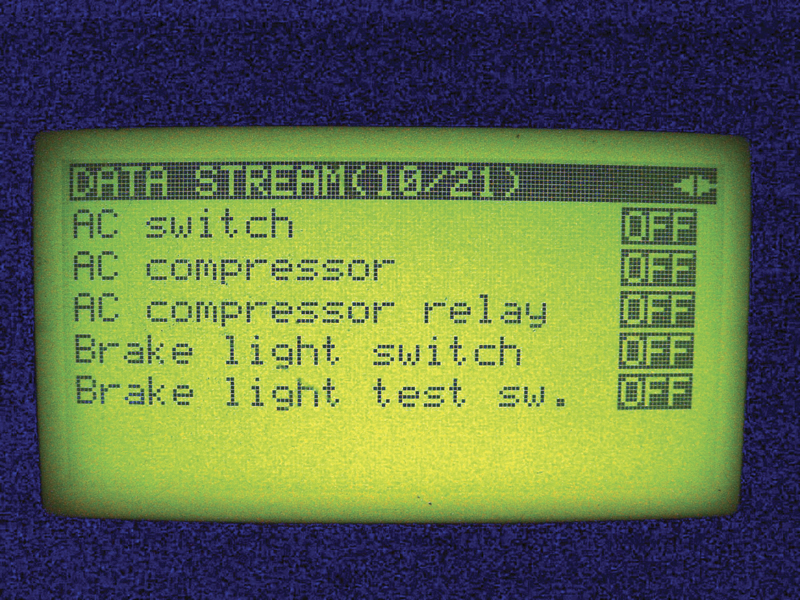
On systems where the DME is in control of compressor operation, there is almost always a PID to indicate if the A/C request is making it to the DME and if the DME is commanding the compressor on. It may not turn the compressor on if the engine temperature is too high.
In the IHKS system, A/C compressor control is provided by the DME unit (the DME also boosts idle speed to account for the additional load of the compressor). The command for A/C starts when the A/C switch provides that input to the IHKS control unit (mounted on either side of the HVAC housing, depending on the model). If the evaporator temperature is above freezing, it allows the A/C request signal to be passed on to the DME through high and low pressures switches. If either switch is open due to excessively high pressure or insufficient refrigerant charge, the command will never make it to the DME unit. We should mention that on the E90, compressor output activation is controlled by the JB (Junction Box).
If the switches are closed, the DME increases idle speed and grounds the A/C relay, which energizes the compressor. While the expansion valve compensates for subtle fluctuations in refrigerant temperatures and pressures, the evaporator temperature sensor can also send a signal to the IHKS control unit to shut off the compressor. Also, as refrigerant pressures increase the high pressure switch can shut off the compressor.
When diagnosing a no-A/C complaint, monitor the A/C request in the engine data. If the request is there, then everything is okay electrically. If the A/C request is not there, check voltages at the high and low [2] pressure switches. Usually battery voltage is supplied from the DME to the IHKS unit through the switches. The IHKS unit grounds this voltage signal to command the DME to turn on the compressor. The low pressure switch will open below 22psi and close at 38psi. The high pressure side of the switch will open above 435psi and close below 305psi. If the pressures are between these limits, they are okay. If the scan tool does not indicate that the compressor is turned on, make sure the signal at the switches is going to ground. If the IHKS control unit is not grounding the signal, check the wiring, then start testing the evaporator temperature sensor input.
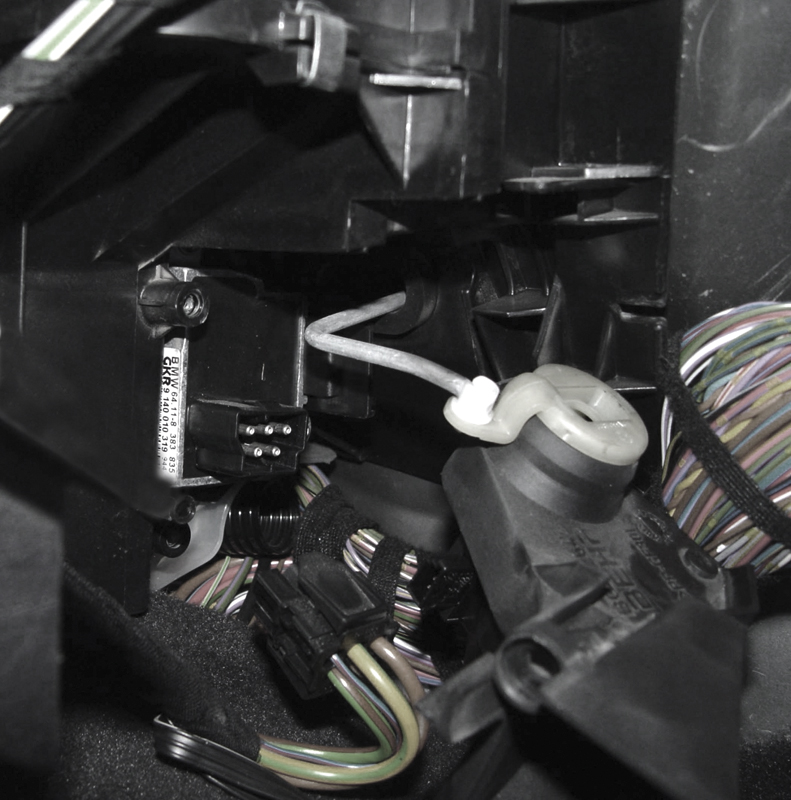
If you’re looking for the blower motor final stage, you’ll find it located in the HVAC control box. In this case, it’s under a door motor. This is an E46 chassis, so once you remove the glove box everything is pretty much there.
There is a bit more involved in IHKR/A systems. These have been around since ’88 on the 7-Series, but here we will focus on the updated IHKA after ’95. Since ’96, BMW has added IHKA to its 3- and 5-Series as well. IHKR/A are feedback systems that monitor inside and outside temperatures and automatically make changes to all of the computer-controlled outputs. One of the characteristics of the updated IHKA is that the control panel is also the control unit. All of the inputs and outputs go through the control unit, so it, not the DME, directly controls the compressor. Previous to ‘94, the control unit sends the A/C compressor request to a Lock Control unit whose job it is to detect if the compressor is seized, and, if it is, shut off power to it. The lock control unit function is now part of the compressor.
Despite all computer-controlled inputs going directly to the IHKA unit, the command signal still must pass through a combination high/low pressure switch on its way to the compressor. The pressure switches open and close at slightly higher pressures than those mentioned above. The low pressure switch opens below 30psi and closes above 40psi. The high pressure switch opens above 475psi and closes below 330psi. Typically, high and low pressures do not cycle the compressor on and off on these systems. The IHKA unit monitors evaporator temperature and cycles the compressor.
The DME still plays a role in compressor activation. A signal is sent from the IHKA to the DME that A/C has been requested. The DME raises rpm, then sends a confirmation signal of this. The IHKA receives the signal and activates the compressor. Without this confirmation signal the compressor will not come on. An engine running at over 240 deg. F. will not allow the compressor to come on. In ’99, BMW did away with the pressure switches and added a pressure sensor to the IHKA list of inputs, but its function remained the same. Due to all the computer controlled inputs and outputs, a scan tool is indispensable in diagnosing any problem, from malfunction codes to monitoring data.
Mode Door and Blower Motor Control
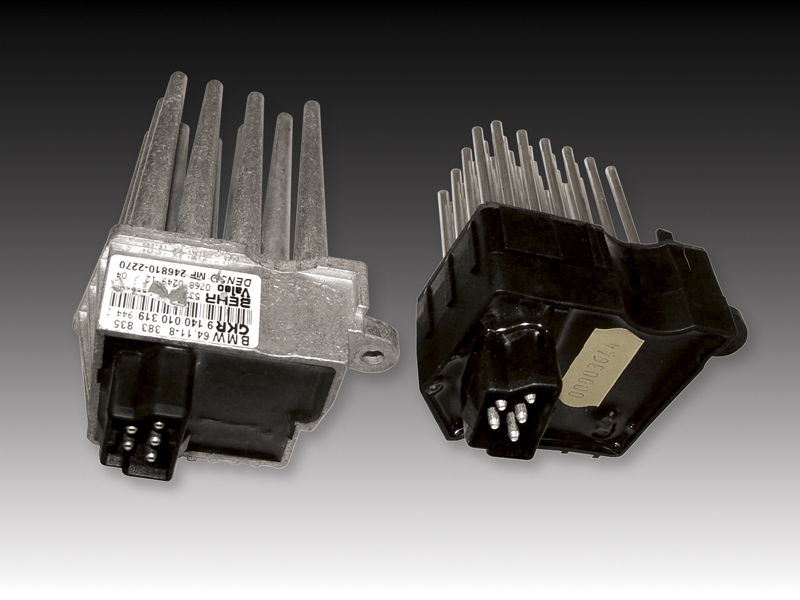
Here are the old and new blower motor final stages. Notice how the replacement unit has more heat sink surface area to dissipate heat. This unit has also been known to stay on with the key off and run down the battery.
Starting with the IHKS system, both the mode and the blower motor are manually controlled except for the fresh air/recirculation flap, which is electronically controlled — voltage is sent from the recirculation switch to pin #3 of the recirculation flap actuator to energize the motor. Otherwise, mechanical linkages open and close the other mode door flaps, and blower motor control is through a resistor block (except at full speed where all the resistors are bypassed).
With the IHKR system, mechanical linkages are used for mode door control, but blower motor operation has changed. Instead of a resistor block, the blower motor uses a “Final Stage” transistor. This provides a variable ground path for the blower motor depending on the pulse-width modulated signal sent from the IHKR control unit. By varying the duty cycle to the Final Stage, it can vary the amount of current that passes through it, thus making the blower motor speed increase and decrease. The IHKA system also uses this Final Stage blower motor control, but the mode doors are not mechanically controlled. There can be up to 10 stepper motors in each system depending on the model. One is the fresh air/recirculation motor.
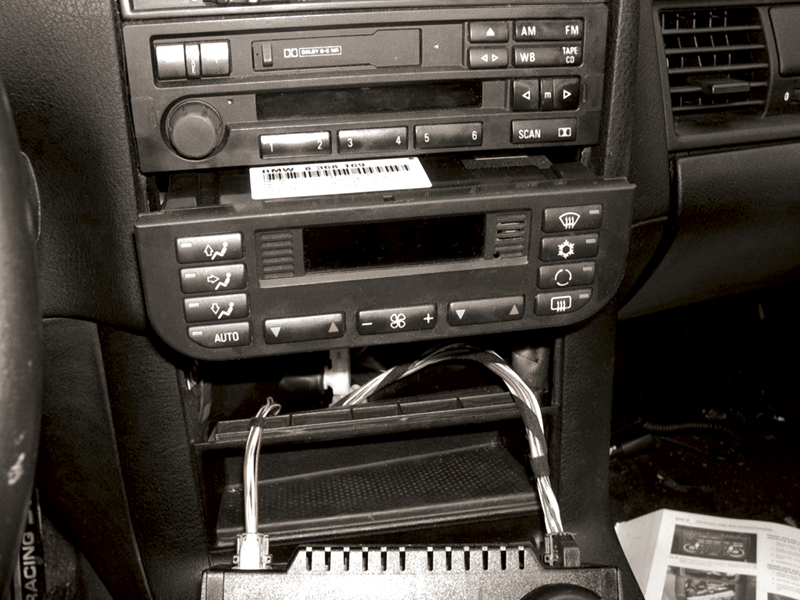
Here is the ’96 E36 control panel. A Sensor test mode can be pulled up by hitting the Auto and Rear Defroster buttons at the same time (two buttons, one on the lower left, the other on the lower right). You can select the next sensor by pushing the blower speed button. To exit the sensor test mode, push the Auto and Recirculation buttons at the same time.
This is operated much faster than the other stepper motors. It’s made to respond more quickly to adjust its opening to compensate for increased road speed, and, if the system has AUC, close the flap when poor air quality is detected.
Previous to ’94, BMW used conventional gear reduction stepper motors. Each motor had four wires to gradually step it into position. On a dual system with rear climate control, there could be up to nine stepper motors and 36 wires to test. Post ’95, BMW introduced the “Smart Stepper Motor.†Each one has its own control unit mounted in it. Power and ground are provided to each motor, and a bus signal is sent to all motors on one wire. Each motor gets its own specific signal, so one motor can move without the others moving. The stepper motors on later-model BMW vehicles are connected via an M-Bus or LIN-Bus. Once again, a scan tool is indispensable in diagnosing these systems.
You can use a digital multimeter to check for power and ground at the motor, and a scope to see the command signal, but all you will be able to tell is that the signal is there. Bi-directional control from a scan tool is necessary to conclusively determine which actuator is failing and why.
| System | IHKS | IHKR | IHKA |
| Temperature Control | Manual | Feedback | Feedback |
| Mode Door Control | Mechanical | Mechanical | Computer |
| Compressor and Cooling Fan Control | DME | DME | IHKA* |
| Blower Motor Control | Resistor Unit | Final Stage | Final Stage |
| *Except E46 and E36, in which the DME still controls the compressor | |||
IHKS/R/A: Keeping things under control
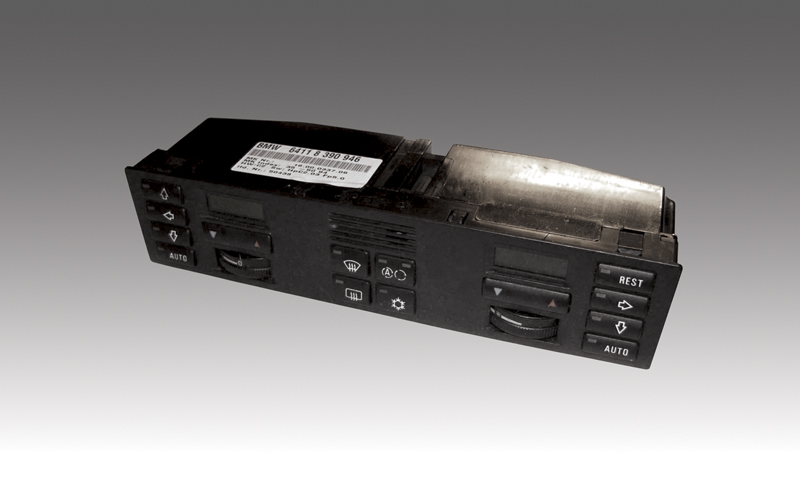
This is a ’95 IHKA control unit, which is no longer available. If it fails, it will have to be replaced with an updated unit. While it does not have malfunction codes, it will give you data. The updated control unit can store up to six codes.
IHKS systems are for the most part manual with some electronic controls. They have three dials to control temperature, blower speed, and mode, and the control unit is separate from the panel. IHKR provides feedback for temperature control and uses a final stage resistor for blower motor control, but everything else is manual. IHKR also has three dials, but there are additional sensors to account for changes in environment and the control unit is incorporated into the panel. IHKA is fully feedback-controlled where the control unit makes decisions programmed into it to provide selected airflow and temperature. The controls are push button for everything and the control unit is part of the panel. For the most part, if the control panel is also the control unit scan tool diagnosis is possible and coding is required when replacing these units. The chart below will help you determine which system you are working on:
On ’96 to early ’97 3-Series a sensor display mode is accessible by pushing the Auto and Rear Defrost buttons at the same time. You can scroll through the various sensors by hitting the blower motor speed buttons. By the way, this will give you sensor data, not voltages. Other than this, there are no self-diagnostic features. A scan tool is a tremendous time saver, as opposed to checking all the signal voltage inputs. If you are going to use your scan tool, here is a short list of temperature input sensors to be checked:
- Ambient Temperature sensor (thru K-Bus IKE)
- Interior Temperature sensor
- Vent Air Temperature sensor (two on Dual Zone)
- Heater Core Temperature sensor (two on Dual Zone)
- Evaporator Temperature Sensor
They all use 5V references, NTC type resistors and have replacement values in the IHKR/A when one of them fails. On the scan tool, look for this replacement value by manipulating the heater control and watch for the scan data not changing. If the evaporator temperature sensor fails, A/C is shut off. A code should also set with this value. These aren’t the only inputs to the IHKR/A systems. Here is a list of the input controls and how they’re applied:
- Mode door control (push button)
- Mode door position sensor (up to 10 stepper motors)
- Temperature request (three wire, two on Dual Zone)
- Center vent air flow (three wire, two on Dual Zone)
- Temperature mixing (three wire, on center vent)
- Mixing door (three wire, in housing)
- Blower motor (three wire, two on Dual Zone)
- Air recirculation sensor (four wire)
- Refrigerant Pressure sensor (three wire)
That is plenty of data to evaluate when diagnosing a climate control issue, not to mention the Y factor. The Y factor is a computer calculated value by which the control unit tells us how much it is trying to change the temperature. There are two on Dual Zone systems. This may give you some indication of what’s wrong if the climate control is not properly adjusting temperature. A feature that may confuse a new owner is that previous to ’96 the driver’s side functions would over-ride the passenger side functions. Since ’96, the Dual Zones operate independently. Another feature that may trick some customers, particularly if the car was purchased used, is the key personality. If you have a wife saying the temperature is always set wrong, and a husband who says the temperature is just fine, the answer is in the keys. When the doors are unlocked the car can determine which key has been used, and engages presets for the climate control system. This is done through coding.
Now that we have an understanding of how IHKS/R/A systems function, let’s go out there and get the job done!


0 Comments